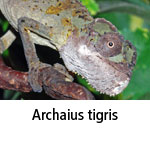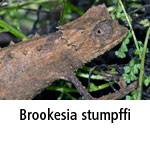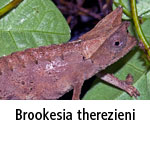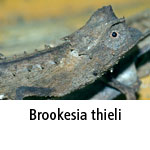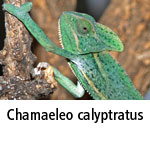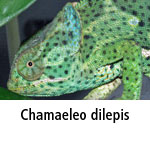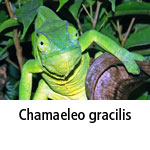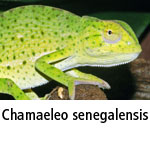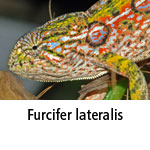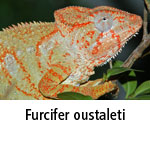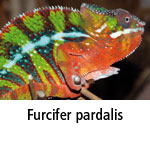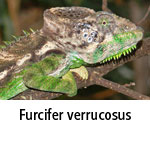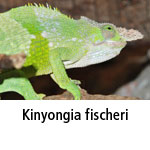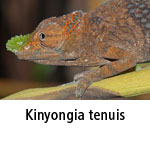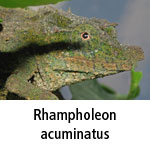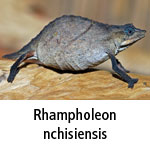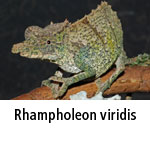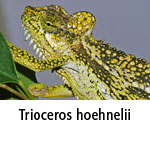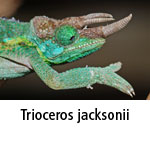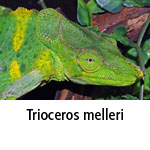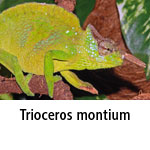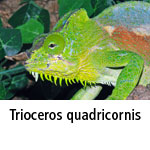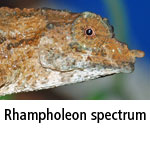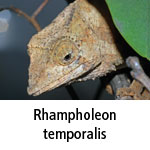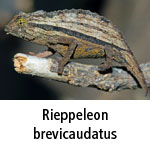
Chamaeleonidae – Chameleons
Within the family of Chamaeleonidae, the chameleons, you find about 160 species in two sub-families: the dwarf or pigmy chameleons (Brookesiinae) and the true chameleons (Chamaeleoninae). Chameleons originate from Eastern Africa, but have spread across the whole continent, and even to India. Two species were deliberately introduced to Europe by humans. Most species live in western Africa and on Madagascar. While the dwarf species of Brookesia live only on Madagascar, and those of Rhampholeon and Rieppeleon are concentrated in the equatorial rank of Africa, the species of Chamaeleoninae spread across the complete distribution area. This family is part of the iguana-likes (Iguania).
About all species of chameleons need very special care, in no case they are animals for beginners without specific knowledge. The diversity of species results in quite different sizes, forms and lifestyles. There are species with only 3.5 cm and some reaching more than 60 cm length, some live on the ground, some on trees and bushes, some in deserts, some in the rain forest, some in the lowlands, some reach the snow line on mountains. Even as captive-breds and in captivity these animals have only a relatively short life span, but at least it is much higher than for animals in the wild. Some wild-caughts have trouble getting used to husbandry, even though the knowledge of successful husbandry has increased exponentially in recent decades. You will get support from good literature and from several interest groups that have specialized on chameleons: in Germany, in the Netherlands, and in Belgium.
About all species of chameleons need very special care, in no case they are animals for beginners without specific knowledge. The diversity of species results in quite different sizes, forms and lifestyles. There are species with only 3.5 cm and some reaching more than 60 cm length, some live on the ground, some on trees and bushes, some in deserts, some in the rain forest, some in the lowlands, some reach the snow line on mountains. Even as captive-breds and in captivity these animals have only a relatively short life span, but at least it is much higher than for animals in the wild. Some wild-caughts have trouble getting used to husbandry, even though the knowledge of successful husbandry has increased exponentially in recent decades. You will get support from good literature and from several interest groups that have specialized on chameleons: in Germany, in the Netherlands, and in Belgium.
Chamaeleonidae – Chamäleons
Innerhalb der Chamaeleonidae, umgangssprachlich Chamäleons, sind rund 160 Arten in zwei Unterfamilien beschrieben: die Stummelschwanzchamäleons (Brookesiinae) und die Echten Chamäleons (Chamaeleoninae). Chamäleons stammen originär aus Ostafrika, sie haben sich aber über das gesamte Afrika und bis nach Indien ausgebreitet. Zwei Arten wurden auch nach Europa eingeschleppt. Die meisten Arten leben in Westafrika und Madagaskar. Während die Stummelschwanzchamäleons der Gattung Brookesia nur auf Madagaskar vorkommen und die Erdchamäleons der Gattungen Rhampholeon und Rieppeleon nur an der Äquatorialebene Afrikas anzutreffen sind, kommen die Echten Chamäleons im gesamten Verbreitungsgebiet der Familie vor. Einen sehr guten und ausführlichen Artikel zu Chamaeleonidae bietet das deutsche Wikipedia. Diese Familie gehört zu den Leguanartigen (Iguania).
Fast alle Chamäleon-Arten benötigen eine sehr spezielle Pflege, sodass sie auf keinen Fall für Anfänger ohne spezifische Kenntnisse geeignet sind. Die Artenvielfalt schlägt sich auch in unterschiedlichsten Körperformen und -größen sowie Lebensweisen nieder. Es gibt Arten von 3,5 bis über 60 cm Länge, Boden- und Baumbewohner, Wüsten- und Regenwaldarten, Flachlandtiere sowie solche, die bis zur Schneegrenze vorkommen. Selbst als Nachzuchten und in Gefangenschaft haben Chamäleons eine relativ kurze Lebenserwartung, allerdings ist diese viel höher als bei Tieren in freier Wildbahn. Manche Wildfänge haben Probleme bei der Umgewöhnung, obwohl sich das Wissen um die erfolgreiche Haltung in den letzten Jahrzehnten exponenziell vermehrt hat. Unterstützung bieten gute Literatur und die Arbeitsgemeinschaft Chamäleons der DGHT. Hier finden Sie Unterstützung in Belgien und den Niederlanden.
Fast alle Chamäleon-Arten benötigen eine sehr spezielle Pflege, sodass sie auf keinen Fall für Anfänger ohne spezifische Kenntnisse geeignet sind. Die Artenvielfalt schlägt sich auch in unterschiedlichsten Körperformen und -größen sowie Lebensweisen nieder. Es gibt Arten von 3,5 bis über 60 cm Länge, Boden- und Baumbewohner, Wüsten- und Regenwaldarten, Flachlandtiere sowie solche, die bis zur Schneegrenze vorkommen. Selbst als Nachzuchten und in Gefangenschaft haben Chamäleons eine relativ kurze Lebenserwartung, allerdings ist diese viel höher als bei Tieren in freier Wildbahn. Manche Wildfänge haben Probleme bei der Umgewöhnung, obwohl sich das Wissen um die erfolgreiche Haltung in den letzten Jahrzehnten exponenziell vermehrt hat. Unterstützung bieten gute Literatur und die Arbeitsgemeinschaft Chamäleons der DGHT. Hier finden Sie Unterstützung in Belgien und den Niederlanden.
Under preparation • In Vorbereitung
